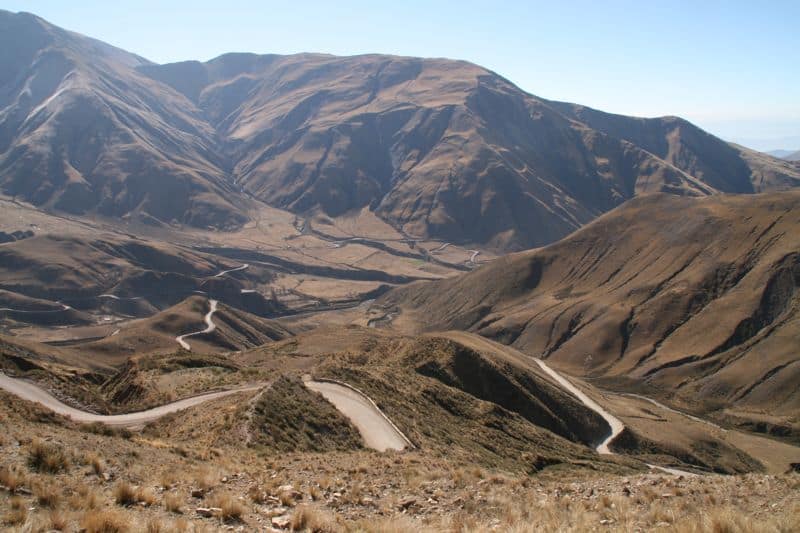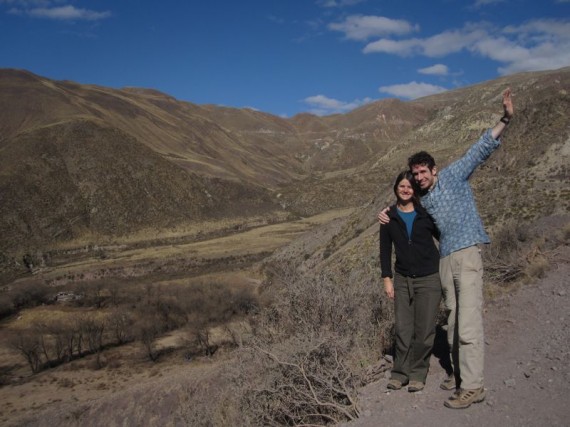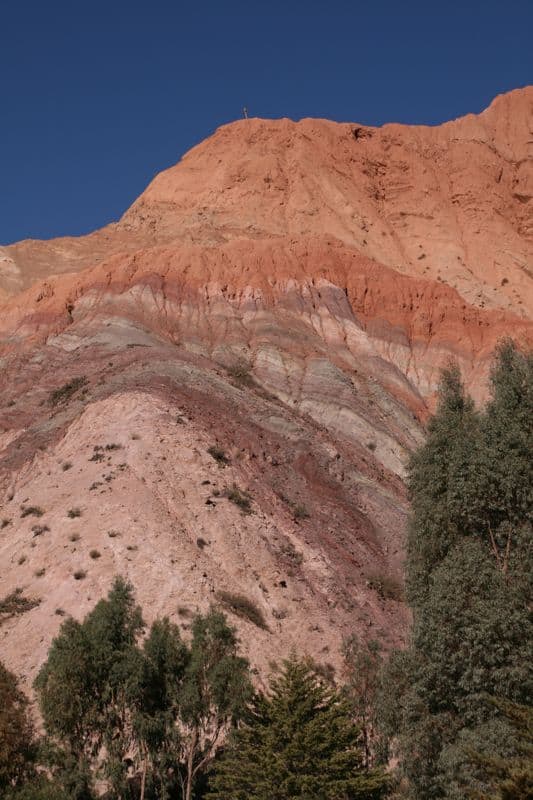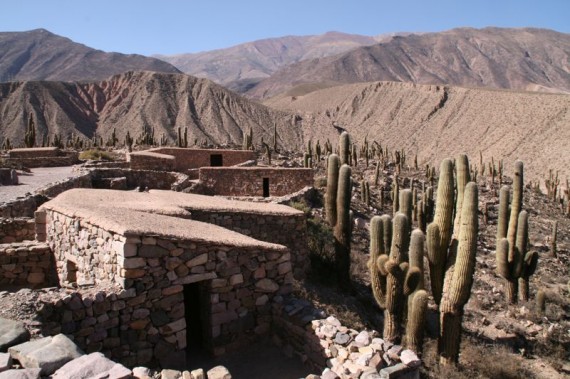This page contains affiliate links. Please read our disclosure for more info.
We rejoin our heroes and their noble beast as they are preparing to leave the wind-swept plains of Cachi. If you haven’t yet experienced the first part of this thrilling theme park ride of a road trip, you can catch up with our travels around the Valles Calchaquíes to Cafayate, Quilmes and Cachi in Part 1.
Day 6: Cachi – Salta – Purmamarca
- 275km
- 3 hours to Salta and 3 hours from there to Purmamarca
- Tarmac. Part gravel from Cachi-Salta.
The Silver Stag continued on, eating up the miles along strips of desert highway laid down through armies of cacti tens of thousands strong, before eventually reaching the edge of La Cuesta del Obispo.
We turned away from the flat plains and suddenly ominous grey rocks rose up either side of the road, leading our metallic stead and its resolute passengers down the only path that this mighty range had deemed suitable for man and his machine.
Gone was the untamed urgency of the miles-long stretches of straight street – this section required a more considered, subtle approach.
Our patience was rewarded as, finally, the craggy rocks opened up to reveal a spectacular panorama and we pulled The Stag to a stop to marvel at the views that confronted us from our vantage point some 3300 metres high.
The snow-topped, green and brown mountains led the eye downwards through fields to a lush, forest valley 1600 metres below.
As we made our way down the windy gravel roads (unfortunately, it was the third type again), the mountains stood proudly overhead, smug in the knowledge of how significant they are and how insignificant we are.
‘Ha,’ they said. ‘Bet we can’t see YOU from space.’
Coming back to the lunch time traffic of Salta after such a beautiful road must feel a bit like going to the supermarket after you’ve walked on the moon – kind of pointlessly stressful. It was made worse by the fact the majority of crossroads don’t have lights or stop signs and driving through can be a little unnerving as everyone tries to second-guess everyone else.
Generally, it seems that the bigger cars get priority but, although the Silver Stag was fairly grand, we didn’t quite have the gumption to pelt through blind crossings on the faith-based basis that most cars are smaller and will therefore give way to you. This, obviously, frustrated the local drivers behind us.
Salteños, we are not.
We stopped for some cheese-based pastries (if you can become a Salteño by simply eating a lot of empanadas, then we’re at least in with a shot) and to slowly readjust to hectic city life before continuing on towards Purmamarca along Ruta 9.
On the map, this is the most direct route.
On the map.
Turns out this ruta is actually a windy, tree-lined mountain track that, while beautiful, gets a little hairy at points and we found ourselves hoping that we wouldn’t meet another car coming the other way.
(Note to Argentine Road Builders – simply putting white lines down the middle of a one-lane street does not magically make it into two lanes.)
We didn’t stop in Jujuy but headed north to Purmamarca in the Quebrada de Humahuaca. It’s a tiny, touristy village of attractive mud buildings in a stunning location beneath the looming multi-hued mountain Cerro de Siete Colores (Hill of Seven Colours).
You can get up close to the beautiful colours on the Paseo de Los Colorados, an easy 3km, 45 minute walk. We had the walk to ourselves, only coming across a few cars (it’s a gravel trail) towards the end, and we counted red, orange, pink, purple, green, grey and yellow in the kaleidoscopic hill.
We like things that are appropriately named.
The narrow streets are filled with handicraft shops and tourist restaurants with live folk music. We knew we’d reached the Andes as we heard panpipes everywhere (and, oh wow, it gets old fast). There was a lot of llama wear for sale and quinoa on the menu and, at an altitude of 2300m, it was also very cold.
Where to Stay
There are a lot of expensive hotels and there wasn’t any bargaining to be had. We found the cheapest options were behind restaurants in the centre. After a lot of searching our basic room with no window and minuscule bathroom cost us 132 pesos so we wouldn’t recommend it. Cheaper accommodation options can be found further up the road in Tilcara.
Where to Eat
We weren’t hopeful about our options amongst all the touristy restaurants but ended up with an excellent meal at Don Heriberto. We shared the 50 peso five course tasting menu which was surprisingly veggie friendly. We were the only people eating there – probably because they played jazz rather than panpipe folklorico (hurrah!) – but the food was imaginative, well presented and very tasty.
Day 7: Purmamarca – Tilcara – Salta
- 160km
- 3.5 hours
- Tarmac
Before turning The Stag back to Salta we stopped in Tilcara, about 20 minutes north from Purmamarca, to visit El Pucará. The ruins of this Incan fortress have been partially restored and, as well as the ubiquitous series of small walls, you can also poke your head into the tiny reconstructed huts and try to imagine what life would have been like as an Inca. Cold was the main thing that sprung to mind.
However, it’s the setting that makes this place special – the stone dwellings are set amongst fields of cacti with views of the coloured rocks of the Quebrada de Humahuaca.
On our way back we took the faster, flatter but far less attractive motorway route along the Ruta 66 from Jujuy to Salta to return our beast to its rightful owner and, thus, end our amazing week.
The Silver Stag
We rented The Stag from Budget, who weren’t any more expensive than the local operators and, after hearing horror stories of people not getting their deposits back from the smaller companies, we decided to opt for the bigger brand.
Of course, given what we’d put the beast through, we were still worried about its reception especially as we hadn’t washed it and it had gone from silver to a kind of dusty, reddish grey. We hoped that it was in pretty good nick underneath its new coat, but given the roads we’d been on we couldn’t be sure.
‘Perfecto,’ our man said.
Even we wouldn’t have gone that far.
We paid 1080 pesos (US$275) for a week, plus an additional 24 pesos a day to reduce our insurance liability from 3000 to 1500 pesos. Our daily mileage allowance was 200km and this was plenty.
It’s expensive but worth it for the freedom we had. We met someone in Cafayate who was frustrated with the tour he was on – although it was quite cheap it was very rushed and he would have liked to spend more time in Cafayate meandering around the bodegas.
Our rental company had a free map of Salta and the surrounding areas that was sufficient for the trip, or you could head to the tourist office and pick one up there.
If you get a chance to explore northwest Argentina we highly recommend renting a car and taking your time because it’s a truly stunning and unique part of the world.




Allow me a little correction.. its “El Pucará” not “La Pukara”
Thank you! I have updated the post.
Hi – we are planning a similar trip but with 3 kids in the back and whilst we are happy to sit in the front and admire the scenery, unfortunately they may not be as enamoured with it after a while! Therefore we want to avoid long stretches of driving without stops if possible. We are planning to arrive in Salta and head straight to Cafayate area for a couple of nights and see Quilmes, then head toward Cachi. We want to go north after that but are unsure whether to go via the road back toward Salta as you did, then head north (I know the scenery on that route between Cachi and Salta is pretty spectacular) or whether we should go north from Cachi – on the map it looks like you can go via La Poma, San Antonio de los Cobres and come out at the salt lake, Salinas Grandes? We would then visit the northern towns from there and drive back to Salta, return the car and stay in Salta for a night. Would you mind letting us know the reason for going north via Salta – would we miss a lot by not going that way? I notice the tours seem to head out towards San Antonio de los Cobres from Salta following the route of the train to the clouds and wonder if that’s the recommended way to go? We have 6 nights altogether in the area. Thanks for any advice and for a great blog post.
Great summary! I also appreciate your honesty about the places you visited and stayed in. I’m actually going to be in this region for 4-5 days in January. We’ll be spending 1-2 days in Salta, but unfortunately I don’t think we have enough time to go to both Calchi/Cafayate *and* the Quebrada de Humahuaca. Since you’ve been to both, which one would you pick if you could only go to one of them?
Thanks in advance!
Either would be great but I’d probably go for Cachi/Cafayate.
Did you get/rent a GPS unit as well when you rented your car?
No we didn’t. It wasn’t too difficult to navigate.
Loved reading about the trip and the very useful information.
We are planning to spend some time around Mendosa and in the North West this Christmas. Driving ourselves. Don’t think we will be doing the round trip over the fifty miles of gravel road! I have a bad back. Was the Stag a four by four?
La Pukara at Tilcara looks amazing!!! Gosh, I can’t wait to do a road trip through Argie one day. :)
It is beautiful: like Quilmes near Cafayate it is as much for the setting as for the ruins themselves.
Were there any towns along your route that you could envision yourselves spending considerable time in?
Cafayate was the only place we would want to spend more time in, mainly because there’s more going on and the weather is much warmer & sunnier.